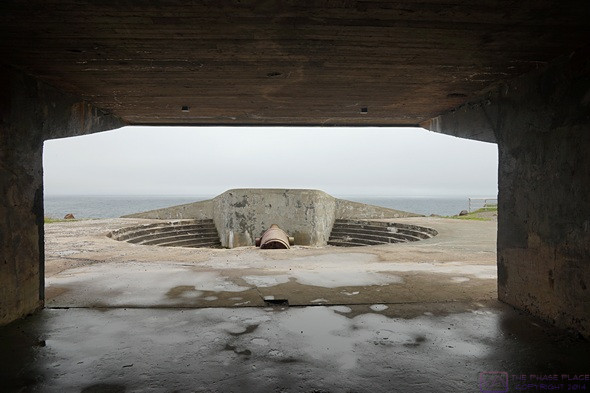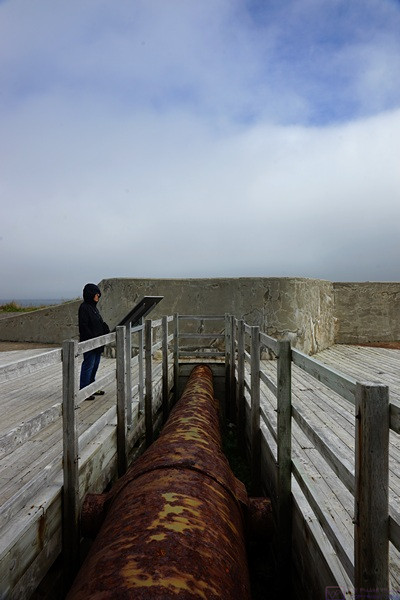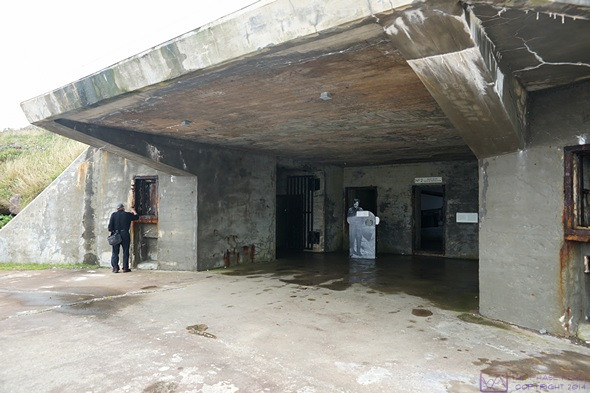THURSDAY 18 August
The third aspect of Cape Spear that made it worthy of being a National Historic Site was its military history. Without recounting all the details, which can be looked up online, the location of Cape Spear had strategic importance for the defense of the coast. In particular, its location had a sweeping view of the North Atlantic Ocean leading into the entrance to The Narrows and subsequently into St. John’s Harbor. As mentioned in a previous blog post, St. John’s was the final staging point for the merchant marine supply convoys, and their Navy escorts, to England during WWII. As such, it was also a prime target for the NAZI Wolf Pack submarines.

The No. 1 rifle platform as viewed from the No. 1 Ready Room. The ready rooms are where the on-duty soldiers were stationed, ready at a moment’s notice to operate their assigned rifle. Barracks, a mess hall, and other buildings were located elsewhere on the site, behind the high ridge and out of sight of the enemy. But so to were the rifles and bunkers. These rifles were supported by a complex mechanism that not only allowed aiming, but also absorbed recoil when fired, and kept them lowered and hidden from view until brought into firing position. A counter-balance was used to offset the weight of the guns when raising them and firing them. In effect, they were not visible from the ocean until the were raised and fired after which they immediately disappeared again. The mechanisms are long gone, but the graphic information panel explaining all of this was fascinating.
Very little remains of the military presence that was once here, as is also the case at the Signal Hill NHS (visible from Cape Spear), but what remains was very impressive and gave us a sense of the “spare no expense, just do what’s necessary” mentality that comes into play during an armed conflict where everything is on the line.

This is the No. 2 rifle. A wooden platform has been added around it so visitors can get an up-close look. As best we could remember, and verify online, they are made of steel, are 367 inches long (30.5 ft or just over 9 m), and weigh 67,000 pounds. They have a 10” bore and fired a 510 lb. shell. Both rifles were in service in New Jersey, USA in 1898 and were sold to Canada in 1941 for use in coastal defense during WWII. A well-trained crew could fire one of these rifles about every 2 minutes.
What remains, however, is an extensive underground reinforced concrete bunker complex that was built to support two very large artillery rifles. (These have “rifled” bores, not the smooth bores that classify something as a “gun.”) Most of the complex was dark and drab, so I didn’t photograph it. Basically, the layout consisted of two “disappearing” artillery rifles, each of which had a “ready room” and tunnels leading deep into the hill for storing projectiles and charges. Each tunnel bent part way along as a safety precaution. Off of the tunnels were the bunkers (store rooms) for the projectiles (shells) and charges, which were always stored separately. An overhead trolley crane system was used to move the projectiles and charges to the areas in front of the ready rooms, and opened onto the rifle platforms as show in the first photo.

This is where the No. 2 Ready Room opens out to the No. 2 rifle platform. It provides a sense of the massive reinforced concrete involved in building this bunker system. And yet, it was not visible from the ocean.
…